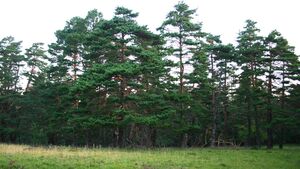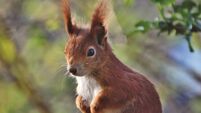Rediscovering one of Ireland's lost treasures

The Scots pine is an evergreen conifer native to northern Europe.
National Tree Day Ireland is an annual event organised by the Tree Council of Ireland that takes place on the first Thursday of October. It focuses on primary schools to help them celebrate trees through fun activities and tree planting. Each year, a different native Irish tree is highlighted, with free saplings provided to participating schools.
The year featured the Scots pine with the theme of 'Building a Better Future’, linking tree planting to clean air, wildlife, carbon capture, and the sustainable use of timber. I was fortunate to be asked this October to help a group of Ox Mountain schoolchildren with the planting of their Scots pine saplings. Like the children themselves, the little trees will need minding for a while but someday they will become fine mature specimens with their own unique story to tell.
Scots pine pollen exists in Irish bogs, indicating its widespread presence thousands of years ago. That was before it was used and overused to the point of extinction. The special pine was eventually reintroduced from Scotland, leading to the name 'Scots pine'. This widespread reintroduction, in the 17th century, was primarily for plantation purposes.
Recent studies have confirmed that a small, resilient population of native Irish ‘Scots’ pine does still exist in Ireland. Scientists discovered a small "microrefugium" of native pine trees in a remote part of the Burren in Co Clare, proving the tree’s survival. This discovery, supported by pollen analysis, confirms the genetic distinction of this native Irish tree from the imported Scottish variety.
The Burren Beo Trust has facilitated the planting of over 1,000 Burren pines across 10 mini-woodland sites in the Burren with the aim of establishing safe sites for this tree. Burren Beo Trust outline what is needed to ensure the tree’s continued survival.
The Scots pine is an evergreen conifer native to northern Europe. Mature trees grow to 35m and can live for up to 700 years. The Scots pine has a distinctive orange-red bark and paired, blue-green needles. It grows in various soils, especially poor and dry ones, becoming a mature tree with a rounded, almost flat crown. Known for its straight trunk, it serves as vital habitat for wildlife, particularly the red squirrel.
Scots pine is the only truly native pine in Ireland. The needle-like leaves grow in pairs on short side shoots. Scots pine is unusual in that both male and female flowers grow on the same tree. Male flowers comprise clusters of yellow anthers at the base of shoots. Female flowers are small, red-purple and globular, and grow at the tips of new shoots. After pollination by wind, the female flowers turn green and develop into cones. They mature the following season, so there are always cones of different ages on the one tree.
Human impact and the gradual change to a warmer, wetter climate led to the decline of our native pine. Pine stumps have been found in bogs, standing where they grew, 7,000 years ago, before the formation of the peat. Irish Tree Explorers Network, a group with attachments to University College Cork, which encourage members of the public to explore science, technology, engineering, mathematics (STEM), and culture through trees, have this to say about early human interaction with Scots Pine in Ireland.
Not that I would recommend that anyone should try this, but its timber is reputed to burn with a very bright flame - probably why the ancients used so much of it.
Historically, because of overuse, Scots pine was very rare in Ireland so it doesn’t feature significantly in Irish folklore. However, there are accounts that suggest that bog pine was used to light fires for midsummer celebrations and this is in keeping with similar traditions in Germany and Britanny.
A better-known ceremonial association with the pine is its use as a Christmas tree. This tradition, which originated on the continent, may have come from an older belief that the bright flame produced by the pine represented the birth of the new year. Themes of renewal can also be seen in Scottish Halloween traditions of the past, where pine torches were carried across fields to bless and fertilise them.
The pine also features in the stories of Fionn MacCumhaill It is said that the warrior Fionn possessed a pine forest which provided for him and his followers, the Fianna, whenever they could not find any game to hunt elsewhere. Here, the pine appears to be associated with bounty and provision. However, in the story of the lovers Deirdre and Naoise, it is said that upon their death, two pine trees grow out of their graves and become entwined, providing a symbol of eternal love.
Here's to the future of our rediscovered ‘Irish’ Pine, giving thanks for its place in legend, its survival, and our hopes for its future. The Burren Beo Trust points to the cooperation that will be needed to ensure its rebirth and growth.





